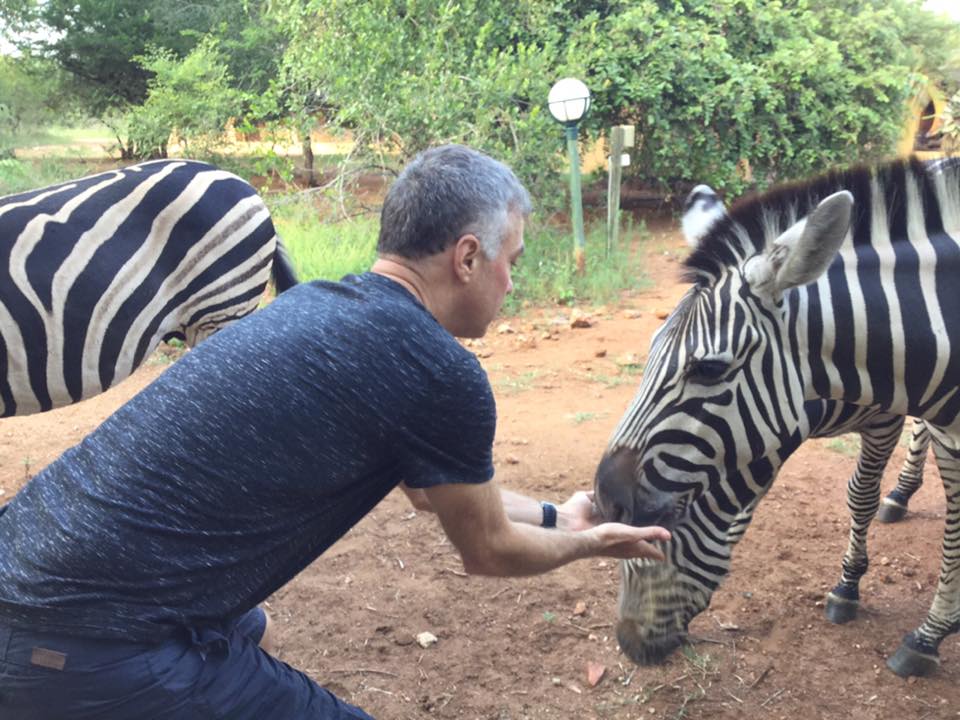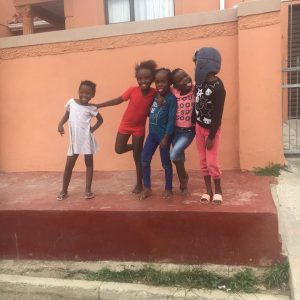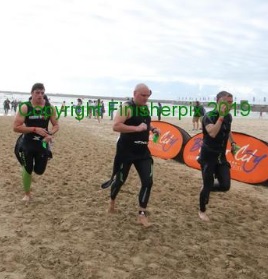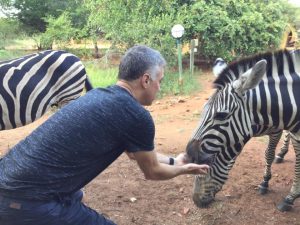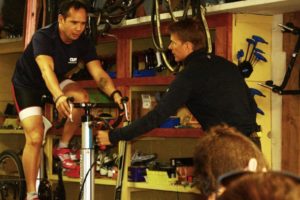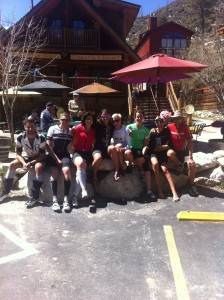- by Mark Brandt, CL Performance Training athlete and student of the world
After finishing Florida full in November 2018 we had ‘the dance’ that so many of us have with our spouses about the next year and the next race. I said I would like to drop down and do all half Ironman for a year. Kathryn Brandt suggested that before I do another race she would really like to go on a bucket list safari trip. Thus was born a plan to race in South Africa – and go on a Safari.
I picked the race in Buffalo City, South Africa based on the date. How bad could racing in South Africa be, right? It would not have changed anything, but apparently I picked the hardest 70.3 half Ironman course in the world. It was not just the waves which were breaking at 8-12 feet to start the race, and bigger beyond the break wall. It was the hills and the wind which almost always blows east to west at this town, and up the hill which we raced on.
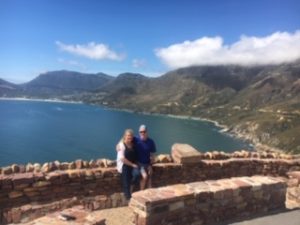 We arrived early on Thursday for a Sunday race, my thought was we would tour this coastal town and see what history and attractions they have. After four days in Cape Town doing just that, we got to the hotel in Buffalo City and asked the activities desk what there was to do. She answered, “I am from here and there is nothing to do here!”
We arrived early on Thursday for a Sunday race, my thought was we would tour this coastal town and see what history and attractions they have. After four days in Cape Town doing just that, we got to the hotel in Buffalo City and asked the activities desk what there was to do. She answered, “I am from here and there is nothing to do here!”
On top of that we were warned that the area next to our hotel was unsafe and that we should take taxis only, even to go a block away at night. We accepted this and settled in to our pre-race regimen of me going to the expo and picking up a few last minute items. I also took on assembling my own bike in the hotel room. I got it done, but it was not pretty. I figured I would have the local mechanic check my work, but the lines were always too long so, my 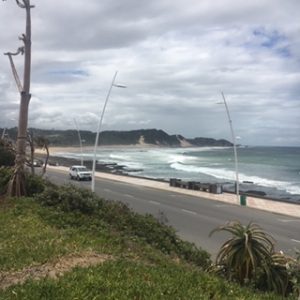 work was what went into the race.
work was what went into the race.
When in Cape Town we did hear of a village tour that took tourists into the shanty towns around the city that are present in every major African village. It could be seen as a weird tourist experience in a very poor area, but I choose to look at it more as a sociologic view of life and to learn from it. We had no time in Cape Town for this tour so we searched for it in East London. We found a tour guide who was willing to take us and it turned out that cruise ships stop at the town – and his was one of the tours they offered the ships.
He explained that both Nelson Mandela and Desmond Tutu went to college together in this town and how it was similar to our Detroit because Mercedes has a massive auto manufacturing plant in town.
The fi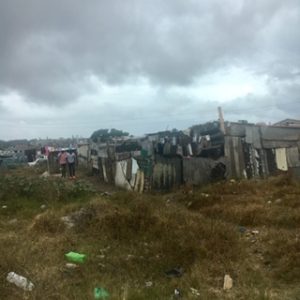 rst stop was at a native medicine pharmacy. We would call it a witch doctor shop. I have never seen so many colors or glass containers holding things that my guide said were roots, bones, dried skin and herbs. The locals believe in this more than modern medicine. He said to the owner that I was here for an Ironman and that I needed something to make me do better in the race. A lady with eyes right out of a movie went in the back and came back with a bottle of liquid that if I were to mix mud, sticks and brownie mix, you would have an idea of what it looked like. She said “this cure everything – 58 ingredients”. I paid the $4 and we left. Kathryn thought I was just being polite but I had plans to try it. The plane flight had swollen up my ankles and I really wanted some relief. I took it exactly as he informed me – two 1/4 glasses at night and one in the morning. In the middle of the night I got out of bed and I swear I had no swelling of any kind.
rst stop was at a native medicine pharmacy. We would call it a witch doctor shop. I have never seen so many colors or glass containers holding things that my guide said were roots, bones, dried skin and herbs. The locals believe in this more than modern medicine. He said to the owner that I was here for an Ironman and that I needed something to make me do better in the race. A lady with eyes right out of a movie went in the back and came back with a bottle of liquid that if I were to mix mud, sticks and brownie mix, you would have an idea of what it looked like. She said “this cure everything – 58 ingredients”. I paid the $4 and we left. Kathryn thought I was just being polite but I had plans to try it. The plane flight had swollen up my ankles and I really wanted some relief. I took it exactly as he informed me – two 1/4 glasses at night and one in the morning. In the middle of the night I got out of bed and I swear I had no swelling of any kind.
On with the tour. The little villages had quite the history, this one was just for the blacks, this one for the colored and this one for the Indians. All of them had been moved before Apartheid was officially disbanded. He explained the rules of this forced separation and the fact that it was against the law for a black and white person to been seen together.
I had been told in Cape Town that the kids like gifts, so I bought a ton of gummies in little separate ba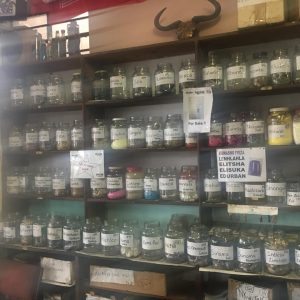 gs. I also brought tangerines and apples in large bags. Our tour guide took us through the business districts of the shanty towns. The little huts had signs for fruit and meat – cuts we might not have ever seen – chicken feet, cow intestines and the like.
gs. I also brought tangerines and apples in large bags. Our tour guide took us through the business districts of the shanty towns. The little huts had signs for fruit and meat – cuts we might not have ever seen – chicken feet, cow intestines and the like.
We finally stopped at a little school. He said that the principal is a friend of his. We went in to meet the nicest lady – a Grandmother who saw the need for a nursery school to cater to kids that are 2-6 years old. She started it for her granddaughters and their friends and it just grew. She got government support for 60 kids. The school is currently at 350 kids with 14 teachers. Some of the families pay, but many do not.
Her school had a fire last year and she did a fund me campaign that worked and they rebuilt two of the major rooms. They still have work to do and they are “selling” doors windows and rooms. (My advertising moment: Folks, $100 dollars is a lot in this part of the world. You can help at https://www.gofundme.com/zamani)
The kids were so gracious to receive a slice of a tangerine or three to five gummies, as the bags of 25 or so were deemed too much for any one child. They had smiles and they were polite. They showed us the entire school which started as the Grandma’s home, and now takes the entire property of maybe 200 feet deep by 50 feet wide. It was clean and well taken care of. She had bathrooms for the kids and a large sink where they would wash their hands. We took pictures of the teachers the room and some of the kids, who posed for us in some of the pictures.
The tour continued into several more neighborhoods where the kids have smiles and are playing with homemade toys. I saw a soccer ball made from a balloon wrapped with tape. I saw a truck made from a milk carton with wheels of bottle lids and this little boy rolling it down the street. I saw a girl playing with a stick and bike tire like it was a hula hoop. The fence around the garden was assembled from discarded box springs minus the material around the metal. No one told these kids they were poor.
We ended the tour at a local bar and restaurant run by the owner’s daughter. It started as a place in his home for just his friends but it grew and he kept adding on. The tour guide explained that this place is considered to have the best food around. She shared a lamb stew that was amazing, along with a home-made alcohol free ginger beer. We met a lady that was hanging out in the communal style seating named Linda. She was very curious about what brought us to her village and we talked for a while. She runs her own company was a single mother of two teenage boys, and explained how hard it was to get ahead. It was a conversation I could have been having anywhere in the world, but this was her story on her home turf. We hugged when she left and she thanked us for sharing our family pictures and story. She said I will follow your Ironman tomorrow and took down my race number.
The race was Sunday morning, and I was up early as always. They announced that due to jelly fish in the ocean, they were cutting the course from 1900 meters to 1150 meters. The locals said this was code for ‘the waves are too high beyond the break wall’. They were breaking like no waves I had ever swum in at the shore, and it reminded me of the many times I took to Columbia Beach with our CTC friends on crazy windy days.
I figured you get out a little ways and the water rolls but the waves do not break on you. The start was really cool, only releasing five swimmers at a time so the water was not as crowded and I was only bumped a few times on the swim. But the start was insane as I ran, and dodged what felt like five major waves. Finally I felt I was out deep enough to start swimming, twice I was wrong and big waves clobbered me again. The Indian Ocean tastes like the Dead Sea!
My heart was racing and I started to hyperventilate, which we train for also. I kept going and finally was able to start a swim stroke and duck under the next two breakers. The waves were so big that sighting was the real problem; if you were on top of the wave the buoys were way below your line of site, and if you were on the bottom of a curler you could not see the buoy at all. I smiled at the lunacy of this race.
My SA friend Ian Hessel warned me that South Africans are different than Americans and they take bigger risks in their races. Boy did he nail that one. In spite of the extreme conditions, I thought I was going to own this swim. I had taken a lot of private lessons this winter and I just kept my stroke strong and long and tried to keep my space in front of my head clear of my arms. The first three turns were all into a brutal current but the last leg the waves actually pushed you to shore, so I body surfed the final leg and passed a lot of people. 1:49 per 100 yards was my time. Respectable!
The transition area was long. I got on the bike and immediately my tri bars started to squeak. Who put this together!? Right – that would be me. I knew the mechanicals of the bike and I knew it would not come apart so I just settled in for a noisy ride. The total climb was stated as 4400 feet but the first 28 miles we hit 3500 of climb and I was not fast on my tri bike going up hills.
When we finally flipped and started down the mountain I was excited because I had learned a lot since I raced in France a few years earlier. I knew that the pros stay aero at all cost going down a hill, even in stiff headwinds or strong cross winds. The conventional wisdom is, if you stay aero, the resistance is not as great and you go faster. This was the brain speaking but the wind and the body was definitely asking ‘are you sure’?
I headed into 30 mile an hour gale forces winds most of the way down. My climbs were slow but I hit 44-48 miles an hour on those downhills and with all but one descent, I stayed aero. I picked up 15 minutes on the second half of the bike portion, 3:15 my slowest 56 mile race ever by almost 30 minutes.
Time to run a half marathon – 13.1 miles. The course went along the Indian Ocean but with the windward so strong I don’t remember ever saying, ‘wow this is beautiful’. I do remember thinking I needed to retire and take up golf many times.
The first two miles were pretty flat, then we started a climb that lasted two miles and had a grade of 8-12 percent. My 7:45 start melted to a 13:20 in no time but my 5k time was 26:30 so I was doing ok. The second 5k time was similar, then the day started really wearing on me and my times started to slip. I also started to cramp near the 12 mile mark. I was very happy to finish this one.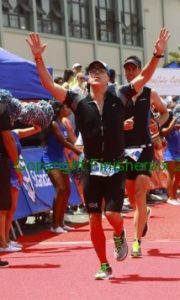
It was my second slowest ever, but a 10th place in my age group of 82 starters and 69 finishers, and the top non-South African in my AG. The hardest race I had completed by far, the two full Ironman were longer but none more painful than this one.
We took off the next morning for a week long Safari in Kruger and the vacation was complete.
This was a life changing experience. Knowing more about the cradle of civilization makes me appreciate the world we live in! Our next big trip is to India in 2020. I do not know if it will include an Ironman event, but it definitely will include understanding more about the caste system, untouchables and poverty.
I find racing is a high class pursuit of what drives us, but I get every bit as excited when I learn about a South African daily plant worker who leaves home at 3:00am and walks 6-7 miles to and from his job daily to show up for work, because it’s what it takes to feed his family. The human spirit is so amazingly strong and resilient. It shows through when the odds are most against us.
My race in South Africa was painful, but the pain a child feels every night going to bed hungry is way, way worse. I saw lots of those kids. It was a society where, in particular, the Grandmother was the one keeping entire families fed, housed and schooled.
All of us need to remember, one person can make a difference and I dare say that one person very well might be me or you!
Editors Note: Race photos courtesy of FinisherPix.
